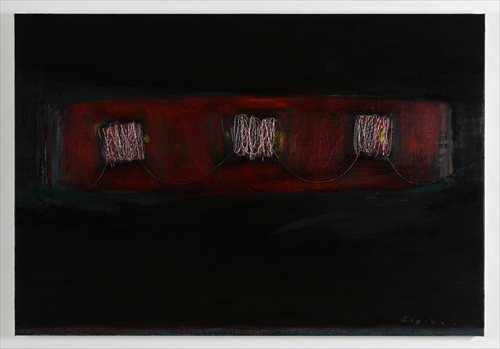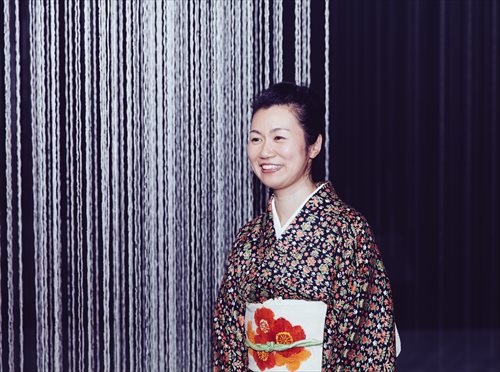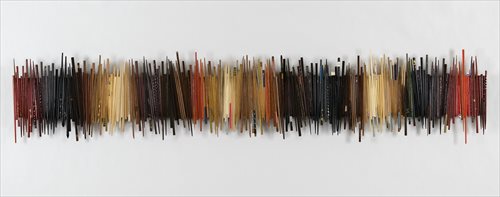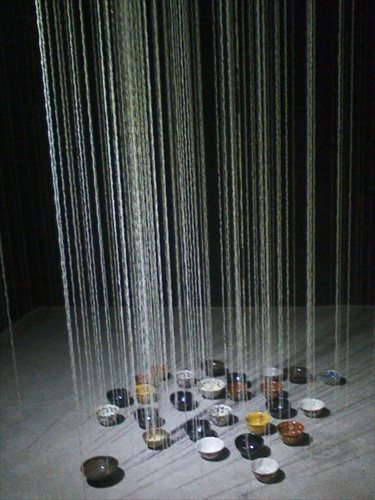Every grain
"Beauty is everywhere. It is not she that is lacking to our eye, but our eyes which fail to perceive her," sculptor Auguste Rodin noted. Japanese artist Sayaka Ishizuka not only perceives beauty in ordinary objects but also turns the simple and common into the rare and ethereal.
At Pearl Lam Galleries in Shanghai, Ishizuka is holding her first solo exhibition outside Japan. Life Threads features 11 new pieces made from everyday objects which are often overlooked due to their ubiquity, such as pieces of thread, broken bowls, grains of rice and a worn-out furniture. The works on display include her best known site-specific installation, mixed media on canvas, chopstick collages on wooden boards and a short video piece.

The Rain Pours

Japanese artist Sayaka Ishizuka

Connection and Genetic

Connection and Genetic

Rice Deity Photos: Courtesy of Sayaka Ishizuka
At the entrance of the exhibition is a large walk-in installation called Rice Deity, which is composed of 4,200 threads of rice grains 3 to 4 meters long that stream from the ceiling to the floor, covering one-third of the gallery. A light shining through the threads from above projects beams on to the floor, creating a dreamlike illusion against the dark backdrop.
"We have always overlooked the unique beauty that lies within common and used objects of our daily lives. A few years ago, I did not appreciate how beautiful a grain of rice could be, especially when light shines through it. But when you stop and take a closer look at some of these common objects, you will be surprised by their subtle beauty," Ishizuka told the Global Times.
In Japanese tradition, inanimate items breathe traces of their users' spirit, memories and personal emotions. "Old and used objects bear the traces of their users. I see these individual traces as the unique 'souls' of the objects," said Ishizuka. "Cotton threads and cloth are the tools needed to make clothes. They are close to the skin and carry traces of their previous owners. Household items bear the mark of age when they are used and become a part of history. The surrounding objects send messages to us. I love to listen to their voices and I really appreciate them."
With a sensitivity for common articles, Ishizuka demonstrates her belief that all lives are connected to one another like continuous intertwining threads.
Rice Deity, especially created for the exhibition, is based on the previous installation of the same name shown at the 2009 Echigo-Tsumari Art Triennial.
Echigo is home to the most famous high-quality rice growing area in Japan and farmers there depend on rice cultivation for their livelihood. When Rice Deity was first exhibited in Echigo in 2009, a local elderly farmer passed by the doorway, read the brochure and expressed his confusion, saying it was sheer waste to use edible rice in the "silly" art. Emerging from the exhibition, however, he exclaimed that the artwork was anything but a waste and had brought the rice grains to life.
Ishizuka came across the words "rice deity" during her reading on rice cultivation, coinciding with her finding of a Shinto shrine in Echigo where a deity of rice harvest was among those worshiped. Shinto, literally meaning "ways of the gods," is a Japanese religion whose practices include worship of ancestors and nature spirits and has evolved into respect for nature in a broader sense.
Japanese children are often told by their parents that little deities live in grains of rice so they must eat up all the grains in the bowl rather than waste them. Similarly, Japanese people put their palms together devoutly before a meal, saying "itadakimasu" which means "I'm receiving gods' blessings humbly," as a sign of gratefulness to nature and the farmers for their labor.
Ishizuka spent half a year living with an elderly rice farming couple in a Japanese village in 2009. During the cultivation process, she discovered that each simple rice grain provided warmth and nutrition while carrying powers of beauty, tenacity and tranquility. Through her simple yet profound artwork, she implies that we share our world with nature and small overlooked objects in life.
During her preparations for Rice Deity in Shanghai, the artist talked about her affinity with rice. "Seeds (rice grains) are pure and precious, too valuable to be harmed. Love is constituted by seeds and they nourish our lives. These beautiful, transparent, delicious grains of rice are imbued with love and integrity. Rice sustains an eternal life chain, from mother to children, from generation to generation."
In Japan and China, rice plays an integral part in sustaining lives and human existence. "I hope the exhibition will encourage people to reevaluate their attitude towards food and life. In Japan, there has been a lot of news about dangerous food with pesticide residue, nuclear contamination, etc. I've also heard a lot about food safety crises in China. In my opinion, ignoring food is equal to ignoring our lives," she said.
The theme of life threads is also displayed in her painting The Rain Pours. She pasted rice grains and white threads on a canvas and covered them with layers of acrylic paint. Then she slowly sanded down the pigment on the rice until the original whiteness underneath was revealed, showing thin delicate rice threads traveling across the shadowy background.
In the collages of Connection and Genetic, colorful chopsticks collected from her friends are lined up horizontally like scrolls on walls. As Japanese people used to hold chopstick offerings in shrines and burn them in prayer ceremonies to purify souls 'living' in there, the color gradation formed by the worn-out chopsticks represents an infinite continuation of life.
"You might have pondered the worn-out tips of the chopsticks, which encourage us to imagine the many scenarios they were in and how their owners used them," Ishizuka said.
Date: Until August 23, 10:30 am to 7 pm
Venue: Pearl Lam Galleries 艺术门画廊
Address: G/F, 181 Jiangxi Road Middle
江西中路181号底楼
Admission: Free
Call 6323-1989 for details
Newspaper headline: Japanese artist celebrates the overlooked items of everyday life